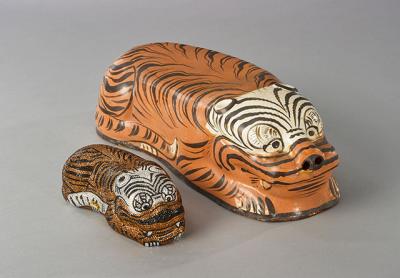Leibers Auction Chinese Artworks at Sotheby's

Judith Leiber is internationally known for her handbags, and Gerson Leiber, her husband, is a noted abstract painter. But when visiting the exhibition hall and storage facility they built on their Springs property, visitors are probably most surprised at their collection of Chinese ceramic objects.
The couple will receive even more attention for their devotion to the medium when Sotheby’s opens an exhibition of their holdings next Thursday before an auction on March 20. Called “Inspired: Chinese Art From the Collection of Gerson and Judith Leiber,” it will feature almost 100 objects, some dating back centuries.
Of particular note are the small evening bags called minaudieres that Ms. Leiber designed based on the objects. They are not part of the sale or exhibition but are represented in some beautiful photos by Gary Mamay.
From their earliest days as a couple in Budapest in the 1940s, the Leibers began collecting Chinese art, attracted by “the art form’s intricate designs and beautiful motifs,” they said in a press release.
Some 20 years later, after the couple immigrated to the United States, Ms. Leiber founded her handbag company, which raised the design of her tiny evening bags to the level of high art. Fashionistas the world over have carried her bags at coronations, inaugurations, and on the red carpet. Mr. Leiber’s paintings and drawings are in museums including the Metropolitan Museum of Art and the Smithsonian.
Of particular interest in the Chinese sale is a pair of Qing dynasty “soldier” vases and covers dating from 1740 that stand 52 inches tall. They are decorated with pheasants in a garden with smaller birds and butterflies and have a presale estimate of $250,000 to $400,000.
A Ming dynasty incense burner or censer and lid is in the form of a luduan, a mythical creature “with the ability to traverse vast distances in a day and to master all languages,” according to Sotheby’s, and “said to appear only in areas where a virtuous leader was present.” The object, which is 13 inches high, has an estimate of $60,000 to $80,000. It dates from the Wanli period of 1573 to 1620.
A cizhou ware tiger-form pillow from the Jin dynasty, which lasted from 1115 to 1234, has an estimate of $12,000 to $15,000 and shows the couple’s engagement with animals. Ms. Leiber was so inspired by the form that she based the design of one of her handbags on it.
According to Angela McAteer, the head of Sotheby’s Chinese works of art department, the Leiber collection is “colorful, whimsical, and vibrant,” allowing the Leibers’ “unique aesthetics to shine through.”
